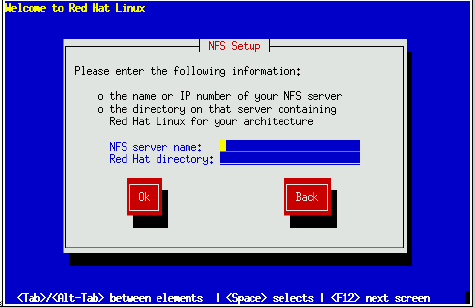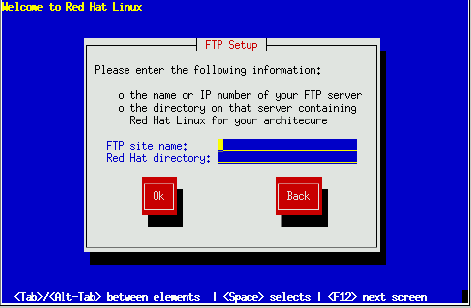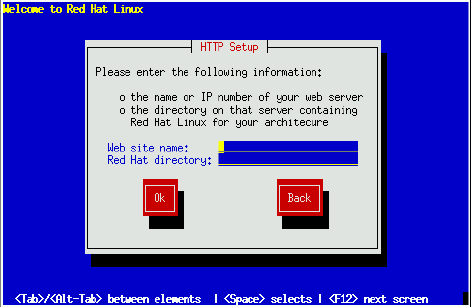Installing over a Network
If you're doing a network installation, the Configure TCP/IP dialog appears; for an explanation of this dialog, go to the section called Configuring a Network Connection and then return here.
NFS Setup
You'll see the NFS setup dialog (Figure 8-7) only if you are installing from an NFS server (that is, only if you booted from a network or PCMCIA diskette and selected NFS Image in the Installation Method dialog).
Enter the name (which must be a fully-qualified domain name) or IP address of your NFS server, and the name of the exported directory that contains the Red Hat Linux installation files or CD. For example, if you're installing from a host named eastcoast in the domain redhat.com, enter eastcoast.redhat.com in the NFS Server field.
If the NFS server has the Red Hat Linux CD mounted on /mnt/cdrom, enter /mnt/cdrom in the Red Hat directory field. If the NFS server is exporting a mirror of the Red Hat Linux installation tree instead of a CD, enter the directory which contains the RedHat directory. For example, if your NFS server contains the directory /mirrors/redhat/i386/RedHat, enter /mirrors/redhat/i386.
After you've supplied information about your NFS boot server, you'll next see the Welcome dialog: go to the section called Welcome.
FTP Setup
You'll see the FTP Setup screen (Figure 8-8) only if you are installing from an FTP server (that is, only if you selected FTP in the Installation Method dialog). This dialog allows you to itentify the FTP server you are installing from.
Enter the fully-qualified domain name or IP address of the FTP site you are installing from, and the name of the directory there which contains the RedHat installation files for your architecture. For example, if the FTP site contains the directory /pub/mirrors/redhat/i386/RedHat, enter /pub/mirrors/redhat/i386.
If everything has been specified properly, a message box appears indicating that base/hdlist is being retrieved.
After you've supplied information about your FTP boot server, you'll next see the Welcome dialog: go to the section called Welcome.
HTTP Setup
You'll see the HTTP Setup screen (Figure 8-9) only if you are installing from an HTTP server (that is, only if you selected HTTP in the Installation Method dialog). This dialog prompts you for information about the HTTP server you are installing from.
Enter the name or IP address of the HTTP site you are installing from, and the name of the directory there which contains the RedHat directory for your architecture. For example, if the HTTP site contains the directory /pub/mirrors/redhat/i386/RedHat, enter /pub/mirrors/redhat/i386.
If everything has been specified properly, a message box appears indicating that base/hdlist is being retrieved.
After you've supplied information about your HTTP boot server, you'll next see the Welcome dialog described in the next section.


